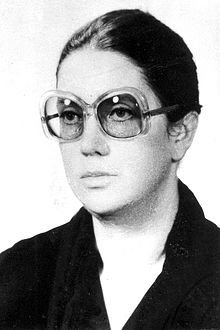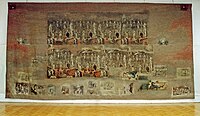Urszula Plewka-Schmidt
Urszula Plewka-Schmidt (born December 29, 1939 in Smogulecka Wieś, Poland ; † January 20, 2008 in Pławno, Poland) was a Polish artist and educator. She was a representative of the new art direction Polska Szkoła Tkacka (Polish Textile School) and author of monumental wall compositions.
Life
She graduated from the Agricultural University in Poznań (1964) and the University of Fine Arts in Poznań (later the Poznań University of Art). She got a diploma in 1966 at the Faculty of Painting in M. Szmańda’s studio. She was associated with this university until 1992.
An artistic debut took place in Magdalena Abakanowicz's studio. From 1980 she headed the studio for color theory at the faculty for interior design . In 1991 she founded the Schola Posnaniensis, the University of Applied Arts, where she was rector and professor until 2007.
plant
At the beginning of her artistic career in the 1970s, she created woven shapes and spatial structures, metal constructions that were covered with hand-woven material. The actions that reflect the emergence of the fabric from the interior, such as: B. "Landscape actions" ("Działania pejzażowe"), which were only recorded with a camera and had the characteristics of a performance. In the later creative period, Plewka-Schmidt returned to traditional textile weaving techniques.
Participation in the important 5th International Biennale of Textile Art in Lausanne (5th Biennale Internationale de la Tapisserie, 1971) opened the door to the international scene for Plewka-Schmidt and thus paved the way for many exhibitions.
The 1979 presentation in Lausanne is seen as a breakthrough in Plewka-Schmidt's creative work , where two monumental works were shown side by side during the International Biennale of Textile Art: " Madonna from Krużlowej " ("Madonna z Krużlowej") and " Marilyn Monroe " - the clash of two ideals of beauty , of past and present, which was to be interpreted as a contribution by the artist to the discussion among artists in the 20th century about the mutual interpenetration of different areas of art.
The theme that is often repeated in the works of Plewka-Schmidt is the reflection on time, the passage of time, the influence of time on people and the interpretation of the tradition of past eras. The artist transposed the well-known works of amateur art as well as cult objects into her wall compositions.
Works
Works by Plewka-Schmidt can be found in the collections of the Kunstgewerbemuseum - Staatlicher Prussischer Kulturbesitz , Berlin, the Pauline Church and Monastery Jasna Góra , Czestochowa, Poland (project with Włodzimierz Schmidt), the Museum of the Beginnings of the Polish State, Gniezno , Poland, the Central Textile Museum, Łódź, Poland, the National Museum , Poznań, Poland, the Musée cantonal des beaux-arts de Lausanne in Switzerland, The Art Institute of Chicago, Chicago, USA, the Vatican Museums , Vatican City and beyond in private collections and -Collections in Germany, France, Israel, New Zealand, Norway, Poland, Switzerland and the USA.
Cycles
- “The journey to the sources of time” / “Podróż do źródeł czasu” /, 1978
- “Time of life, time of death” / “Czas życia, czas śmierci” / 1986
- “The Gardens of Memory” / “Ogrody pamięci” /, 1987
- “This 20th Century” / “Ten XX wiek” /, 2001
Exhibitions (selection)
- 1971 5th International Biennale de la Tapisserie, Lausanne
- 1972 The Central Textile Museum, Łódź "Woven compositions"
- 1973 6th International Biennale de la Tapisserie, Lausanne
- 1975 7th International Biennale de la Tapisserie, Lausanne
- 1977 Poznań City Exhibition "Tapestry Exhibition" *
- 1979 9th International Biennale de la Tapisserie, Lausanne
- 1980 The Central Textile Museum, Łódź “A journey to the sources of time” / “Podróż do źródeł czasu” /
- 1980, 1982, 1984 Chateau de Copet, Geneva: solo exhibitions
- 1981 10th International Biennale de la Tapisserie, Lausanne
- 1985 National Philharmonic , Warsaw - Presentation of the tapestry series "Chopin"
- 1987 Jacques Baruch Gallery, Chicago - solo exhibition "UP-Schmidt tapestry"
- 1988 Interart 88, Poznań - solo exhibition - tapestries and room installations
- 1992 Atena Gallery, Warsaw, Nowy Świat, tapestry exhibition (solo exhibition from the 7th International Triennial of Textile Art, Łódź 92)
- 1997 Art Center - Galeria El, Elbląg, “UP-Schmidt; Monumental tissue "
- 1997 Hertogenbosch, Provinciehuis
- 2000 Municipal art exhibitions, Gorzów Wielkopolski - solo exhibition
- 2000 Modern Art Gallery in Kołobrzeg - solo exhibition
- 2001 Central Textile Museum, Łódź, 10th International Triennial of Textile Art - solo exhibition
Prices
- Scholarship from the Ministry of Culture and the Arts, 1974
- Poznańskie Voivodeship Prize for special achievements in the field of cultural promotion, 1979
- Holy Brother Albert Chmielowski Prize for works with a sacred theme, 1988
- Poznań City Culture Prize, 1989
- Prize from the Minister for Culture and Art for special achievements in the field of didactics and education
- Medal “Ad Perpetuam Rei Memoriam”, Poznań Voivodeship, 1996
- Medal of the Central Textile Museum in Łódź (10th International Triennial of Textile Art) 2001
literature
- Zawisza, N., Scenografia do ..., tekst do retrospektywy, Poznań, 2001
- Wróblewska D., Fiber Art and world Image; Wimmer G., Contemporary Polish Fiber Art; Bar-Or G., The Background to the Polish Revolution in Textile Art / w: / Contemporary Polish Fiber Art., Ein Harod 1991
- Mainguy Ch., Pomnier S. Thomas M., L'Art Textile, Paris 1985 (Edition: Skira)
swell
| personal data | |
|---|---|
| SURNAME | Plewka-Schmidt, Urszula |
| BRIEF DESCRIPTION | Polish artist and educator |
| DATE OF BIRTH | December 29, 1939 |
| PLACE OF BIRTH | Smogulecka Wieś , Poland |
| DATE OF DEATH | January 20, 2008 |
| Place of death | Pławno , Poland |






